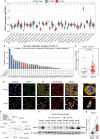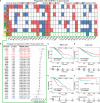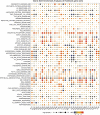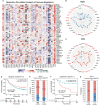Sperm Autoantigenic Protein 17 Predicts the Prognosis and the Immunotherapy Response of Cancers: A Pan-Cancer Analysis
- PMID: 35592314
- PMCID: PMC9110779
- DOI: 10.3389/fimmu.2022.844736
Sperm Autoantigenic Protein 17 Predicts the Prognosis and the Immunotherapy Response of Cancers: A Pan-Cancer Analysis
Abstract
Background: Sperm autoantigen protein 17 (SPA17) is a highly conserved mammalian protein that participates in the acrosome reaction during fertilization and is a recently reported member of the cancer-testicular antigen (CTA) family. It has been reported that the SPA17 expression is limited in adult somatic tissues and re-expressed in tumor tissues. Recently, studies have found that SPA17 regulates the progression of various cancers, but its role in cancer immunotherapy is not clear.
Methods: The pan-cancer and normal tissue transcriptional data were acquired from The Cancer Genome Atlas (TCGA) and the Genotype-Tissue Expression (GTEx) datasets. We explored the SPA17 pan-cancer genomic alteration analysis in the cBioPortal webtool. The Human Protein Atlas (HPA) and ComPPI websites were used to mine the SPA17 protein information. We performed a western blotting assay to validate the upregulated SPA17 expression in clinical glioblastoma (GBM) samples. The univariate Cox regression and Kaplan-Meier method were used to assess the prognostic role of SPA17 in pan-cancer. Gene Set Enrichment Analysis (GSEA) was used to search the associated cancer hallmarks with SPA17 expression in each cancer type. TIMER2.0 was the main platform to investigate the immune cell infiltrations related to SPA17 in pan-cancer. The associations between SPA17 and immunotherapy biomarkers were performed by Spearman correlation analysis. The drug sensitivity information from the Connectivity Map (CMap) dataset was downloaded to perform SAP17-specific inhibitor sensitivity analysis.
Findings: SPA17 was aberrantly expressed in most cancer types and exhibited prognosis predictive ability in various cancers. In addition, our results also show that SPA17 was significantly correlated with immune-activated hallmarks (including pathways and biological processes), immune cell infiltrations, and immunoregulator expressions. The most exciting finding was that SPA17 could significantly predict anti-PDL1 and anti-PD1 therapy responses in cancer patients. Finally, specific inhibitors, like irinotecan and puromycin, which correlate with SPA17 expression in different cancer types, were also screened using Connectivity Map (CMap).
Conclusions: Our results reveal that SPA17 was abnormally expressed in cancer tissues, and this expression pattern could be associated with immune cell infiltrations in tumor microenvironments. Clinically, SPA17 not only acted as a potent prognostic factor to predict the clinical outcomes of cancer patients but was also a promising immunotherapy predictive biomarker for cancer patients treated with immune-checkpoint inhibitors (ICIs).
Keywords: CMap; immunotherapy response; pan-cancer; prognostic biomarker; sperm autoantigenic protein 17 (SPA17).
Copyright © 2022 Tu, Peng, Long, Li, Wu, Huang and Zhu.
Conflict of interest statement
The authors declare that the research was conducted in the absence of any commercial or financial relationships that could be construed as a potential conflict of interest.
Figures






Similar articles
-
Protein Disulfide-Isomerase A3 Is a Robust Prognostic Biomarker for Cancers and Predicts the Immunotherapy Response Effectively.Front Immunol. 2022 Mar 25;13:837512. doi: 10.3389/fimmu.2022.837512. eCollection 2022. Front Immunol. 2022. PMID: 35401558 Free PMC article.
-
The cell senescence regulator p16 is a promising cancer prognostic and immune check-point inhibitor (ICI) therapy biomarker.Aging (Albany NY). 2023 Mar 23;15(6):2136-2157. doi: 10.18632/aging.204601. Epub 2023 Mar 23. Aging (Albany NY). 2023. PMID: 36961395 Free PMC article.
-
Predictive role of E2F6 in cancer prognosis and responses of immunotherapy.Int Immunopharmacol. 2024 Jan 25;127:111302. doi: 10.1016/j.intimp.2023.111302. Epub 2023 Dec 9. Int Immunopharmacol. 2024. PMID: 38071912
-
Cell Division Cycle-Associated Protein 3 (CDCA3) Is a Potential Biomarker for Clinical Prognosis and Immunotherapy in Pan-Cancer.Biomed Res Int. 2022 Aug 30;2022:4632453. doi: 10.1155/2022/4632453. eCollection 2022. Biomed Res Int. 2022. Retraction in: Biomed Res Int. 2023 Jun 21;2023:9870382. doi: 10.1155/2023/9870382. PMID: 36082153 Free PMC article. Retracted. Review.
-
Assessment of RACGAP1 as a Prognostic and Immunological Biomarker in Multiple Human Tumors: A Multiomics Analysis.Int J Mol Sci. 2022 Nov 15;23(22):14102. doi: 10.3390/ijms232214102. Int J Mol Sci. 2022. PMID: 36430577 Free PMC article. Review.
Cited by
-
The Comprehensive Role of High Mobility Group Box 1 (HMGB1) Protein in Different Tumors: A Pan-Cancer Analysis.J Inflamm Res. 2023 Feb 14;16:617-637. doi: 10.2147/JIR.S386898. eCollection 2023. J Inflamm Res. 2023. PMID: 36820147 Free PMC article.
-
Unveiling the significance of cancer-testis antigens and their implications for immunotherapy in glioma.Discov Oncol. 2024 Oct 29;15(1):602. doi: 10.1007/s12672-024-01449-4. Discov Oncol. 2024. PMID: 39472405 Free PMC article. Review.
-
Multi-Omics Analysis and Verification of the Oncogenic Value of CCT8 in Pan-Cancers.J Inflamm Res. 2023 May 29;16:2297-2315. doi: 10.2147/JIR.S403499. eCollection 2023. J Inflamm Res. 2023. PMID: 37273485 Free PMC article.
-
Thioredoxin related transmembrane protein 1acts as a prognostic indictor and promotes proliferation and TMZ resistance of lower-grade glioma.Sci Rep. 2025 Feb 12;15(1):5246. doi: 10.1038/s41598-025-89908-y. Sci Rep. 2025. PMID: 39939413 Free PMC article.
-
Systematic Characterization of DNA Methyltransferases Family in Tumor Progression and Antitumor Immunity.Technol Cancer Res Treat. 2024 Jan-Dec;23:15330338241260658. doi: 10.1177/15330338241260658. Technol Cancer Res Treat. 2024. PMID: 38847740 Free PMC article.
References
Publication types
MeSH terms
Substances
LinkOut - more resources
Full Text Sources
Research Materials

